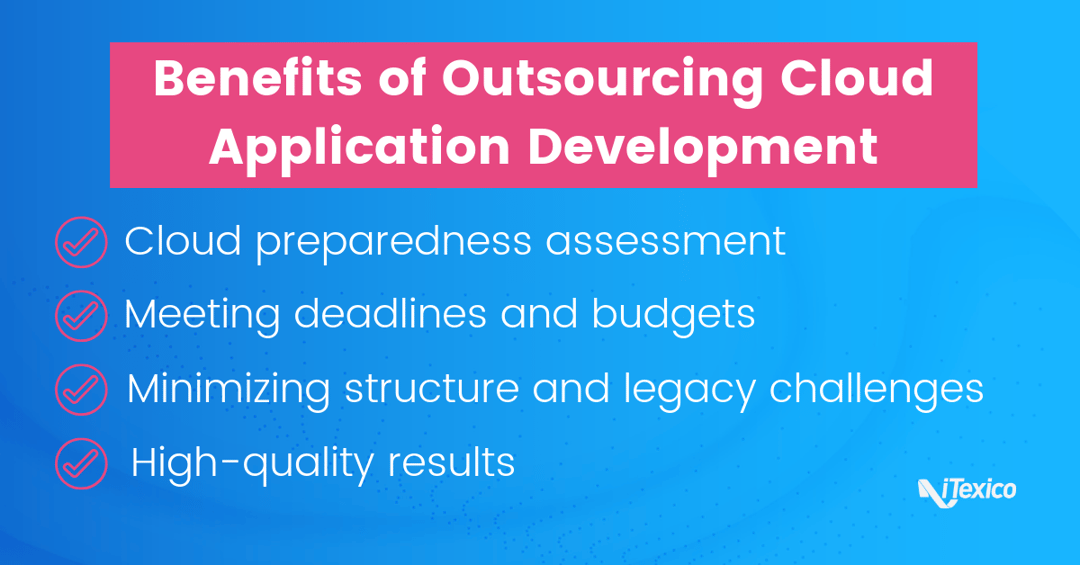The internet is, without a doubt, one of humanity’s greatest achievements made in its lifetime. Connecting everyone on Earth, from the comfort of your desktop to the portability of your phone, was within living memory a pipe dream of impossible magnitude. Sometimes you need to take a step back to appreciate how far we’ve come.
As encompassing as the internet has become in regards to how the world as a whole functions, we’ve really only just begun to scratch the surface of everything it’s capable of. As technology continues to advance, there will certainly be better things to come, but for now? The cloud represents the future, both for companies and individuals alike.
As will all progress, those who refuse to budge will be swept away by the current. Rather than being broken against the rocks, it’s better to consult, comprehend, and integrate the new features that technology affords us to keep up with the competition.
What Is Cloud Development?
Put simply, cloud development refers to software developers utilizing the internet as a structural interface - such as in a browser - to develop new apps. Historically, native development relies on companies using their own servers to develop products, shifting the burden and costs of that work onto their shoulders. Cloud development, by using a third-party service like Google to host their development on the cloud, is a cost-effective, efficient alternative for cloud computing apps.
As the cloud has become a more feasible option for businesses to take advantage of, cloud development, in turn, has seen a massive surge of popularity. This growth of attention and functionality derives from the cloud’s ability as a business solution encompassing an integrated development environment. That, of course, isn’t even including the benefits for application lifecycle management and security testing components.
That got a little thick at the end there, so let’s explain real quick before moving on:
- Integrated Development Environment (IDE)
- An application comprised of any interface a programmer will need to effectively work on software development. Instead of a programmer needing to stitch together multiple utilities to work on a program, an IDE provides a single cohesive toolset of sorts.
- Application Lifecycle Management (ALM)
- The lifecycle of an app from its conception to when it’s ready to be publicly released. Everything from QA testing to project management can be considered a part of the process.
- Security Testing
- Ensuring that the app will be sufficiently protected against attacks and malfunctions while in use.
Before cloud computing, all your development would need to be done literally in-house. A company’s servers could only provide so much room for use, and it certainly couldn’t be accessed from everywhere. However, by leveraging cloud computing now, any organization can bypass the need for hardware to store their information.
Cloud computing provides a means for organizations to safely store and share data from anywhere, anytime. The internet, after all, is easily accessible whether you’re on vacation in another country or at home from the office. Accessibility is the key toward increasing efficiency and improving collaboration.
The question then becomes: why should companies deal with the hassle of migrating to the cloud and the ensuing cloud adoption? Sure, there are benefits, but making that huge transition is assuredly going to be a tripping hazard as far as development goes. If your organization is working fine as it is now, without cloud computing, then why should you try to fix something that isn’t broken?
“Broken” isn’t the operative word here, it’s “inefficient.” It’s progress and embracing the future. According to a 2017 study, it’s estimated that it would only take five years for 95% of workloads to run in the cloud, with AI and machine learning driving most of the cloud engagement by 2020. It’s 2019 now, and the use of the cloud as a basis for cloud computing development has been right on track thus far.
Perhaps what’s most important, however, is the connectivity that cloud application development services offer to all. As of now, 24/7 connectivity is the norm, meaning businesses are able to be reached at any hour, any day of the week. This capability means that they’re able to engage with customers, employees, and stakeholders around the world at any time they need or choose.
If you blinked and missed it from earlier, setting up your organization to fully integrate cloud app development means you’re going to be relying on a third-party to handle the workload for you. It can be a bit daunting, and chances are it might not be the easiest ride. The benefits, however, massively outweigh the troubles you’ll go through along the way.
Letting a reliable cloud application development company deal with the infrastructure in your place can provide a low cost-effective solution, especially when organizations are open to outsourcing. Taking the plunge is the first step, and it gets easier after that.
Benefits of Outsourcing Cloud Application Development

You may have come to this conclusion on your own, but it’s worth reiterating: cloud app development is different from developing in traditional systems. Traditionally, organizations would have their own hardware and software that provided everything their programmers would need to do their jobs. Cloud development is more or less about cutting out the hardware part of the equation, which tends to make things a lot easier.
Cutting out the hardware aspect for cloud computing development ultimately makes things more abstract. You’re no longer able to interact with the physical hardware, after all. Cloud computing development instead provides a real-time virtual environment hosted on different servers at the same time.
This abstraction is good, though. Unbinding yourself from dependence on hardware means developers can be given access to data and projects from virtually anywhere conceivable at the same time. Not only that, but this same abstraction makes outsourcing easier than ever. Without being constricted by hardware, outsourcing companies can freely access and work on your projects from any remote location. Convenience and accessibility, again, are the operative words here.
For convenience and accessibility, you’re going to want to turn your attention to nearshore outsourcing your work. Mexico, among other applicants, is a pristine choice, providing you with a cost-effective selection of high-quality candidates to cover your projects while you shift your attention to other core competencies.
Chances are you’re interested in more detailed accounts of what nearshore outsourcing cloud app development can do for your company. We’ve provided some of the benefits of leveraging nearshore outsourcing for cloud app development that guarantee an increase in productivity and profit.
Cloud Preparedness Assessment
As the Boy Scout motto goes: be prepared. An organization should always have an insight into how their cloud app development is proceeding, but keeping up with those tabs may become costly if proceeded through with other methods. Outsourcing, thankfully, is a perfect solution for this.
By outsourcing, you’re providing yourself with a means to have full insight into the currents stats on your project without bearing weight on your resources. If you decided to independently hire someone to work on the project, you’d have to burn time and resources on them. If it became an in-house project, you’d need to use resources that may help other critical projects to stay updated.
Business is about managing resources. By outsourcing your cloud computing development, you’re opening up options for your organization. You’re able to maintain full insight into your projects’ development without sacrificing resources or time to other sources.
Not only does it provide an efficient means to maintain attention to the quality of your development, cloud app development outsourcing smooth out production. Any concept starts out as a rough idea before it fully takes form, and app development is no stranger. Outsourcing provides the tools and care necessary to streamline a process from a rough outline to a detailed plan on how to move to the cloud.
Meeting Deadlines and Budgets
Deadlines are a pain no matter what field you get into. With all of the projects and work, you’ll be focused, meeting every deadline becomes more of a hassle than an expectation. The more work you subject your employees too, the less you’ll get done.
Outsourcing provides you with the means to not overburden your employees while still meeting your deadlines. Rather than keeping everything in-house, having a dedicated team of outsourced professionals on hand means you’re able to maintain consistent productivity on your cloud projects.
That, of course, is only half the benefit of outsourcing. Hiring through local outsourcing companies may deliver on the results you’re hoping for, but they tend to be more expensive. The answer lies in opting for nearshore outsourcing companies for cloud development.
Nearshore outsourcing companies deliver on the same quality work, dictated by USMCA guidelines, that guarantee competitive work with U.S. and Canadian companies. The difference between them is in cost. Nearshore outsourcing, rather than going locally, results in comparable high-quality work at a much lower cost. Ergo, your budget will be perfectly sound.
Minimizing Structure and Legacy Challenges
Partnerships with companies you can trust are the backbone of a secure, long-lasting relationship. A strong partnership with a reliable nearshore cloud application development company can only serve you all the better in managing an efficient structure.
Developing the trust and partnership with a nearshore development company means you’re able to confidently expect quality products with confidence. While they’re working on the assigned projects, organizations can ensure that all the infrastructure is regularly maintained, and that legacy issues are taken care of in the development process.
Oversight is the key principle here. While you’re certainly capable of having an objective viewpoint on the status of your projects via other means, nearshore outsourcing provides you with a perspective that doesn’t cost you extra resources.
High-Quality Results
Structure, efficiency, communication, everything else set aside, there’s one thing that matters most: a high-quality product. Even if everything else were on point, if a company could not deliver on a good product, then the whole system is a bust.
Nearshore outsourcing is capable of providing exactly the sort of high-quality results you’re looking for in your business. For example, GDL has become a tech hub that’s been attracting companies to take their outsourcing business to Mexico due to the highly skilled talent pool found there. Qualified laborers, combined with the cost-efficiency provided by outsourcing, supply the grade-A cloud app development that’s expected anywhere.
The cost-efficiency is primarily derived from the differentials in the cost of living between the U.S. and Mexico. Since their cost of living is so much lower, organizations can hire top talent at a fraction of the cost without disenfranchising the employees. This way, organizations can ensure they’ll receive high-quality products for their cloud app development projects in a meaningful, beneficial way.
Taking the Plunge
Transitioning to a cloud-based development system isn’t necessarily going to be the easiest thing in the books. Then again, name something truly worth doing that is easy? It takes some effort, but the end product is well worth the time and resources poured into it.
Cloud development, as opposed to what’s provided with native servers, is the most cost-effective solution for companies to develop their cloud computing apps. Without the reliance on hardware, cloud development can be done from anywhere at any time, saving resources, focus, money, and more. These benefits are only compounded when a nearshore outsourcing team is used to full advantage.
At iTexico pride ourselves on providing companies with the opportunity for growth through nearshore outsourcing. With our Nearshore Plus service, we provide U.S. organizations with nearshore outsourcing companies in Mexico for effective partnerships. Contact us.
Moving from a native server to a cloud-based system may be nerve-wracking, but it’s the right move to make. The plunge is the scariest part, but the return you get is exhilarating. Sort of like bungee jumping.





Post Your Comment Here